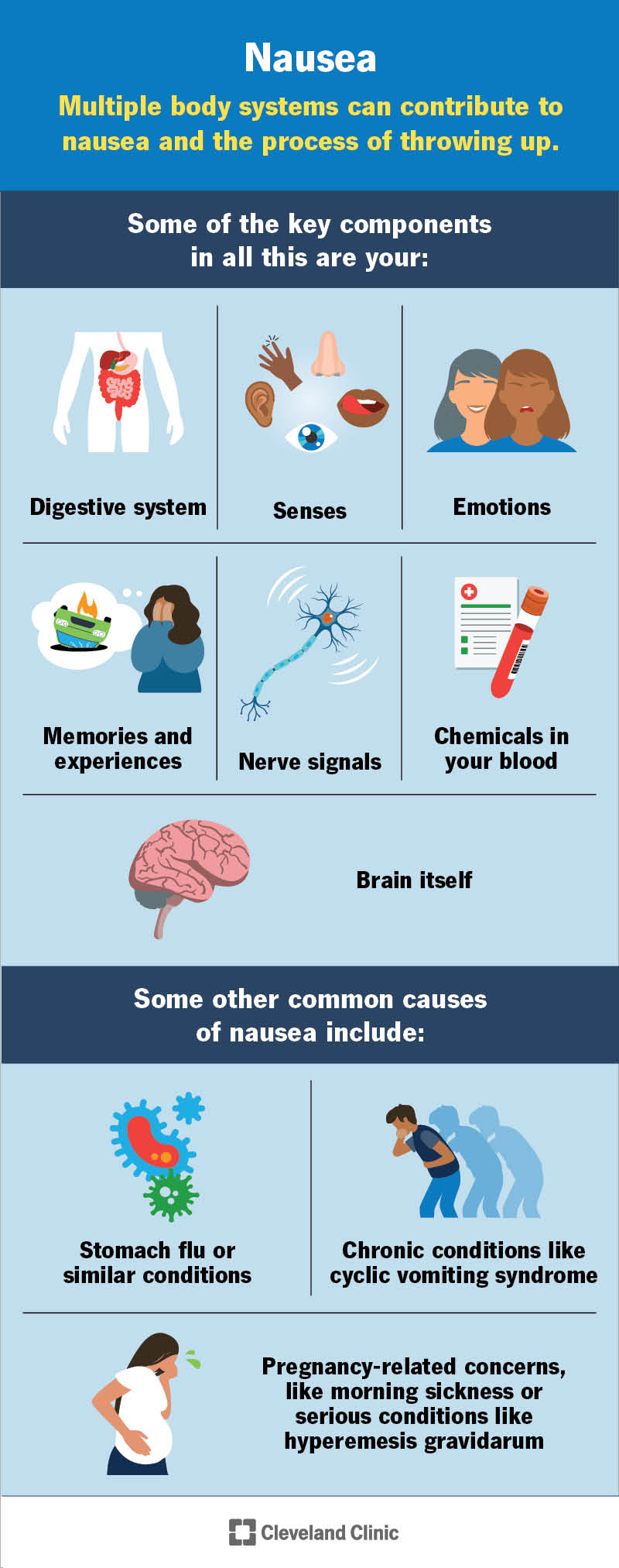Nausea can make it feel like your stomach is ready to do somersaults, sending whatever’s inside right back up and out. Virtually everyone experiences nausea at some point, but that’s not much consolation when it’s happening to you. Fortunately, there are several things you can try to ease it.
Advertisement
Cleveland Clinic is a non-profit academic medical center. Advertising on our site helps support our mission. We do not endorse non-Cleveland Clinic products or services. Policy

Nausea is the feeling that you need to vomit (throw up). It can happen for dozens — if not hundreds — of reasons. Whether you vomit depends on factors like how strong your feeling of nausea is and what caused it. And it’s common for people to experience nausea with no other symptoms and without ever vomiting.
Advertisement
Cleveland Clinic is a non-profit academic medical center. Advertising on our site helps support our mission. We do not endorse non-Cleveland Clinic products or services. Policy
Nausea is often protective. It can be your body’s natural response to consuming something toxic or an illness like food poisoning. But nausea can also happen for other reasons that range from unhelpful and unpleasant to disruptive and disabling.
Feeling nauseated (or nauseous) can start from a number of sources. Some common causes of nausea include:
Multiple body systems and processes can contribute to feeling nauseated, including:
Advertisement
Nausea may be treatable with temporary changes in your routine, especially what and how you eat and drink. Some changes that may help include:
If your nausea is frequent or predictable, you might be able to manage it with antiemetic drugs. That includes over-the-counter (OTC) medications like:
There are also prescription medications. These include, but aren’t limited to, the following:
Medical cannabis also sees use for treating nausea. But this varies depending on where you are and the laws there. A healthcare provider can tell you more about whether this is an option for you.
Remember, just because something’s available over the counter doesn’t mean it’s automatically safe. And OTC remedies are typically not meant for frequent or long-term use.
It’s always best to ask a healthcare professional, like your primary care provider or a pharmacist, for guidance. They can tell you if OTC treatments are safe and how to use them. And they can also tell you if you need professional care or a prescription medicine rather than something available over the counter.
Nausea usually isn’t dangerous on its own. But when it’s frequent or long-lasting, it can start to disrupt your life. It can lead to issues like dehydration, malnutrition and unexpected weight loss. And if nausea is happening because of another condition, diagnosis and treatment can often stop it before it worsens.
Whether nausea is preventable depends on why it’s happening. For example, nausea from car-related motion sickness may be preventable. You might be able to do that either with medication or even just adjusting where you sit in the car. But nausea from other causes may not be preventable.
Advertisement
If you’re experiencing nausea and want to know if it’s preventable, talk to a healthcare provider. They can help you find out the cause of your nausea, whether it’s preventable and what steps you’d need to take to stop it from happening.
Nausea on its own usually doesn’t need medical care unless it’s severe enough to keep you from getting proper nutrition and hydration. Or if it’s frequent and disrupts your life.
Feeling queasy or sick to your stomach is never fun. Maybe it was something you ate, or you got a whiff of something gross. No matter what the cause, nausea is something everyone wants over and done with as soon as possible.
If you’re experiencing nausea, fear not. Most of the time, you can do something to help ease this symptom and get back to life as usual. But if your nausea is more persistent and disruptive, call your healthcare provider. They can help find the cause of your nausea and offer treatments and guidance to help. That way, you can get your stomach settled and feel like your usual self again.
Advertisement
Cleveland Clinic’s primary care providers offer lifelong medical care. From sinus infections and high blood pressure to preventive screening, we’re here for you.

Last reviewed on 09/16/2025.
Learn more about the Health Library and our editorial process.